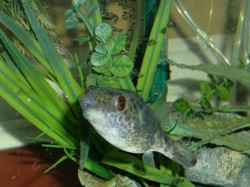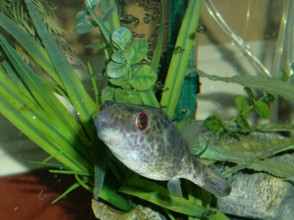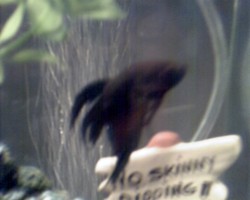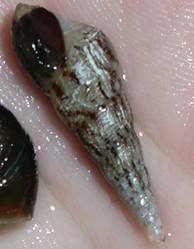
Keeping Freshwater Pufferfish As Pets
With the right amount of care, and proper supplies, freshwater pufferfish can make very enjoyable aquarium fish. However, it is vital to do your research before you purchase one.
Unfortunately, freshwater pufferfish often receive a bad rap as aquarium pets because many aspiring puffer keepers end up purchasing a puffer that has been mislabeled as being a true freshwater fish. For instance, Green Spotted Puffers are not a freshwater fish - yet nearly all pet stores that carry them sell them as such. Instead, GSP require a high end brackish environment in order to thrive in captivity.
Freshwater Pufferfish Require Excellent Water Quality
Do Not Introduce a Puffer to an Uncycled Tank
In addition to maintaining good water quality in your puffer tank, you will also need to make sure that you wait long enough for your fish tank to finish cycling before you introduce your new pet to its home. Scaleless fish are very sensitive to elevated Ammonia and Nitrite levels, and your newly established tank will be fluctuating in water chemistry for at least 6 weeks before it stabilizes.
All puffers are considered scaleless fish. Because of their lack of scales, pufferfish require pristine water conditions so that they don’t suffer from fish problems, like ammonia burn and eventual death. In order to keep the fish tank clean enough for a puffer to live in, you will need to ensure they are housed in a large enough fish tank set up, the tank is adequately filtered, and that you are performing large, frequent water changes at least every week.
Feeding Freshwater Pufferfish
Hard Foods are Necessary
However, some of the larger species of freshwater pufferfish will require you to get creative when it comes to providing a hard meal. Whole shrimp, shell on, are a good addition to any puffer diet – mollusks and crabs work as well. Regardless of the type of hard food you choose to feed your puffer, you will need to make sure that you incorporate them into its diet frequently. If you do not keep their teeth filed down, they will grow so long that your puffer won’t be able to close its mouth, or even swallow its food anymore – if this happens, you will lose your fish if you can’t find anyone to help you file its teeth down.
Once your tank is ready for its new charge, you will need to make sure that you have a steady supply of hard foods on hand. Freshwater pufferfish have a beak that is very similar to rodents’ teeth in that they continually grow unless they are regularly filed down. If you have a smaller species of puffer, like a dwarf puffer, then regular pest snails will work perfectly for this job – I like to use ramshorn snails and pond snails for mine.
You might also like
Choosing a Betta Fish for Your ApartmentBettas make perfect pets for small spaces, such as dorm rooms, classrooms, an...
Pest Snails in the AquariumFor some people, pest snails are one of the most frustrating fish problems. P...




 Beginner's Guide to Keeping Freshwater Puffers as Petson 09/29/2011
Beginner's Guide to Keeping Freshwater Puffers as Petson 09/29/2011
 Cycling a Freshwater Pufferfish Tankon 06/01/2011
Cycling a Freshwater Pufferfish Tankon 06/01/2011
 Pest Snails in the Aquariumon 06/02/2011
Pest Snails in the Aquariumon 06/02/2011
 Why Do I Have Black Algae in My Fish Tank?on 06/02/2011
Why Do I Have Black Algae in My Fish Tank?on 06/02/2011


Comments